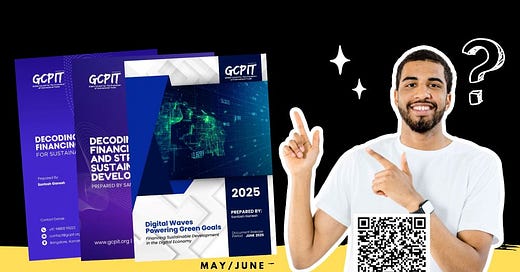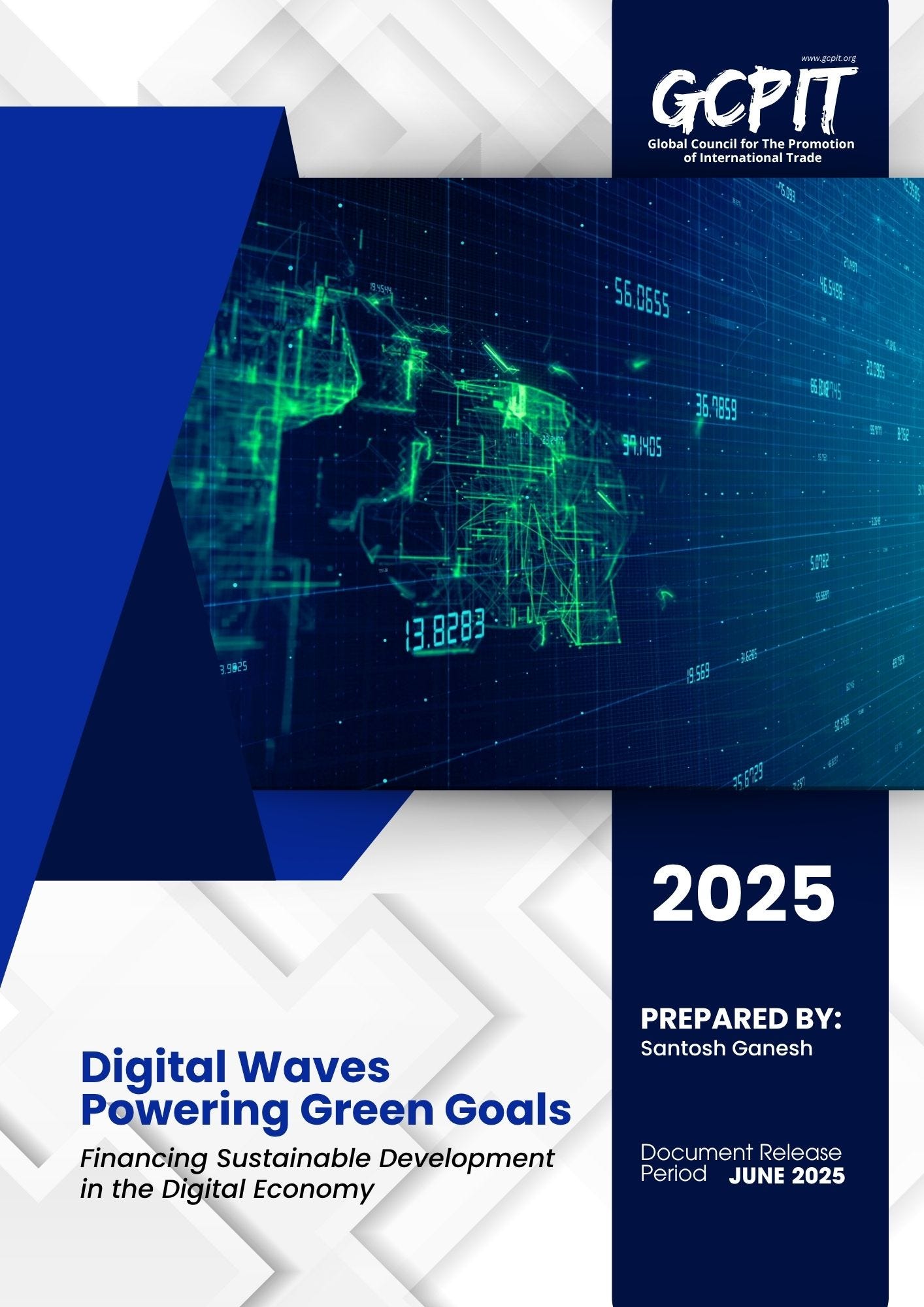Digital Waves Powering Green Goals: Financing Sustainable Development in the Digital Economy
Dear Readers,
Digital Waves Powering Green Goals: Unveiling Our New Report!
The global race to achieve the Sustainable Development Goals (SDGs) and the Paris Agreement targets is on, and innovative financing is paramount. We're thrilled to announce the release of our comprehensive research report: "Digital Waves Powering Green Goals: Financing Sustainable Development in the Digital Economy."
Grab the copy of the report now - Click to access
This in-depth study explores the dynamic intersection of digital transformation, green finance, and the sustainable development agenda. As we navigate a world grappling with a significant sustainable financing deficit, our report unpacks how cutting-edge digital technologies are not just an option, but a necessity.
What You'll Discover Inside:
The Digital Toolkit for Sustainability: Learn how technologies like Artificial Intelligence (AI), Blockchain, the Internet of Things (IoT), and Big Data analytics are revolutionizing how we approach sustainable development financing. From sophisticated climate risk assessment to ensuring the integrity of green bonds, the digital impact is profound.
New Mechanisms, New Capital: We delve into key mechanisms in the digital economy – think digital banking offering green products, the rise of digital green bonds and tokenized ESG assets, and climate-focused crowdfunding platforms – that are unlocking fresh avenues for climate action and SDG achievement.
Fintech, Regtech & Open Banking in Action: Discover the crucial role these innovations play in expanding access to green capital, especially for vital Micro, Small, and Medium-sized Enterprises (MSMEs) in emerging markets, and in enabling climate-smart investments.
Global & Local Momentum: The report examines influential policy frameworks and global initiatives like the EU Green Deal and the G20 Sustainable Finance Working Group, alongside inspiring case studies from Africa, Asia, Latin America, and the EU, showcasing successful digital-finance models for green goals.
Navigating the Challenges: We don't shy away from the hurdles. The report critically assesses risks such as the digital divide, the threat of greenwashing in the digital sphere, data privacy concerns, ethical AI considerations, and regulatory gaps.
The Future is Green & Digital: Look ahead with us as we explore how Digital Public Infrastructure (DPI), Central Bank Digital Currencies (CBDCs), the continued surge of climate fintech, and advanced ESG analytics can catalyze truly inclusive green growth.
This report offers not just analysis, but forward-looking recommendations for governments, financial institutions, and digital innovators. It's a call to action for a collaborative, multi-stakeholder approach to ensure that these powerful digital waves are harnessed effectively and ethically, steering us towards a sustainable and equitable future aligned with Agenda 2030 and the Paris Agreement.
We believe this research provides crucial insights for anyone involved in finance, technology, sustainability, and policymaking.
Dive in and explore how we can collectively power green goals with digital innovation!
Case Studies: Digital Finance for Green Goals Across Regions
The application of digital finance to achieve environmental and sustainability objectives is manifesting in diverse ways across the globe. These case studies illustrate successful models and highlight the adaptability of digital technologies to various regional contexts and green goals.
Grab the copy of the report now - Click to access
Africa:
M-KOPA (Kenya, Uganda, Tanzania, Nigeria, Ghana, South Africa): A prominent fintech and solar energy provider, M-KOPA utilizes a Pay-As-You-Go (PAYG) model to offer solar home systems and, more recently, smartphone financing to underserved rural and peri-urban populations.52 The model is deeply integrated with mobile money platforms like M-Pesa, allowing customers to make small, regular payments. Smart data, including AI-driven analytics, is used for credit assessment, enabling financial inclusion for those without formal credit histories. IoT technology embedded in the solar systems allows for remote monitoring and control, which underpins the PAYG model.
Green Goal: Primarily clean energy access (SDG 7) and financial inclusion (SDG 1, 8, 10).
Impact: M-KOPA has connected over 5 million customers to solar energy and smartphones and unlocked over USD 1.5 billion in credit.52 After successfully repaying their initial solar loan, customers gain access to a broader range of financial services, including cash loans (SolaPesa) and e-vouchers for agricultural inputs, further promoting economic development.78
Digital Technologies: Mobile money, IoT, AI analytics, digital lending platforms.
Alliance for Financial Inclusion (AFI) - African Financial Inclusion Policy Initiative (AfPI): While not a single company, AfPI is a crucial initiative focused on strengthening MSME financing ecosystems across Africa, where the finance gap is particularly acute.70 It supports the development of policy frameworks encompassing regulatory environments, financial infrastructure, dedicated support for women-led SMEs, and agri-finance. An important aspect of this is the establishment of regulatory sandboxes in countries like Kenya, Sierra Leone, Mauritius, Mozambique, Uganda, and Nigeria, designed to foster fintech innovation in a controlled environment.85
Green Goal: Enabling policy for MSME finance, which can include green finance.
Digital Technologies: Focus on enabling fintech and digital financial services.
Asia:
RevFin Services (India): This green fintech company specializes in financing electric vehicles (EVs) for underserved segments, including first-time borrowers and gig economy workers, primarily in Tier 2 and Tier 3 cities.76 RevFin employs alternative credit scoring methodologies, such as psychometric analysis, biometrics, and gamification, to assess creditworthiness.
Green Goal: Promoting sustainable transportation (reducing emissions) and financial inclusion.
Partnerships & Impact: Key partnerships include collaborations with Hero Electric to finance 250,000 electric two-wheelers and Sun Mobility to deploy 100,000 EVs with battery-swapping solutions.76
Digital Technologies: AI-driven credit assessment, digital lending platform. The source paper also mentions blockchain generally for transparency in sustainable lending platforms.76
Grameen Shakti (Bangladesh): A pioneering social enterprise, Grameen Shakti has been instrumental in bringing renewable energy solutions (Solar Home Systems - SHSs, biogas plants, improved cooking stoves) to rural Bangladesh.111 Its model relies heavily on a micro-credit system, requiring a 15% down payment with the remainder payable in installments over 1-3 years.
Green Goal: Rural renewable energy access, improved livelihoods, and CO2 emission reductions.
Impact: Over 1.5 million SHSs have been installed, benefiting approximately 10 million people and saving an estimated 350,000 tonnes of CO2 annually by displacing kerosene.112 The initiative also included training programs for women in renewable energy technologies, aiming to integrate them into the value chain.111
Digital Technologies: While the core model is micro-credit, the scale of operations today would invariably involve digital tools for loan management, customer service, and impact tracking, though not explicitly detailed as the primary innovation in the older cited materials.
Digital Green Bonds (Hong Kong & Hitachi, Japan): These represent cutting-edge applications of blockchain in green finance.
Hong Kong: Issued a $756 million digital green bond in February 2024, the largest of its kind to date. The issuance involved major international banks like Bank of China (Hong Kong), Crédit Agricole CIB, Goldman Sachs, and HSBC.26
Hitachi (Japan): Issued a JPY 10 billion (approx. $69 million) digital green bond in 2023. This bond utilizes BOOSTRY's blockchain platform for issuance and incorporates a "Green Tracking Hub" developed by Hitachi and JPXI, leveraging Hedera DLT, to provide investors with real-time information on the bond’s environmental impact.26
Green Goal: Efficient and transparent financing of green projects.
Digital Technologies: Blockchain, Distributed Ledger Technology (DLT), smart contracts, and potentially IoT for impact data collection.
Latin America:
Sistema.bio (Mexico-based, operations in LAC, Kenya, India): This company provides affordable biodigester units to small and medium-scale farmers, enabling them to convert animal waste into biogas for cooking and organic fertilizer.113 A key aspect of their model is the use of carbon finance to subsidize the purchase price of the digesters. Farmers effectively receive the carbon revenue upfront through this subsidy, in exchange for transferring the environmental attributes (carbon credits) to Sistema.bio.
Green Goal: Renewable energy (biogas from waste), sustainable agriculture (biofertilizer), GHG emission reduction (methane and CO2), improved health (reduced indoor air pollution), and gender equality (reduced time for women collecting firewood), aligning with multiple SDGs (SDG 3, 5, 7, 13).
Monitoring & Impact: Sistema.bio uses a combination of surveys, multi-day in-field testing, and sensors to accurately monitor usage patterns and quantify impact.113
Digital Technologies: Digital databases for Monitoring, Reporting, and Verification (MRV) of carbon projects; sensors (IoT) for usage data.
General Fintech for Financial Inclusion: The region has seen various policy initiatives like regulatory sandboxes (e.g., in Colombia, Brazil, Mexico) and discussions around open banking to spur fintech development, though overall fintech impact on financial inclusion has been mixed compared to other regions.71 IDB Invest highlights digital platforms like Ecoins (Costa Rica), which uses a digital platform (with plans for blockchain) for recycling incentives, and EatCloud (Colombia), which uses SaaS and AI for food rescue and redistribution, as examples of technology enabling circular economy models.74
European Union:
European Green Digital Coalition (EGDC) Sectoral Applications: This coalition of ICT companies aims to develop and deploy green digital solutions across key sectors like energy, transport, manufacturing, agriculture, and smart cities.103 A core component is the "Net Carbon Methodology," a science-based approach to estimate the net GHG emission reduction or avoidance by specific ICT solutions, considering both enabling effects and the solution's own footprint.
Green Goal: Systemic GHG emission reduction through digitalization across sectors.
Digital Technologies: A wide array of ICT solutions, data analytics for the Net Carbon Methodology.
PAUL Tech (Germany - IoT for Energy Efficiency): This company provides an IoT-based solution to optimize heating systems in residential buildings, claiming potential energy consumption cuts of up to 40%.40 The system uses AI to analyze real-time data from sensors and motorized valves, implementing "adaptive hydraulic balancing" to ensure efficient heat distribution.
Financing Model: The solution is often financed through an "Efficiency as a Service" model, where building owners or tenants pay for the achieved energy savings rather than the upfront cost of the technology. This is supported by entities like the Solas Sustainable Energy Fund and the European Investment Bank's (EIB) Private Finance for Energy Efficiency (PF4EE) initiative, making upgrades more accessible, especially for SMEs.40
Green Goal: Energy efficiency in buildings, CO2 reduction.
Digital Technologies: IoT sensors, AI algorithms.
#SustainableFinance #DigitalTransformation #GreenFinance #ESG #ClimateAction #Fintech #Innovation #SDGs #ParisAgreement #DigitalEconomy #Sustainability #TechForGood
We encourage you to share this announcement with your networks.
Sincerely,
Global Council for the Promotion of International Trade (GCPITGHQ)






